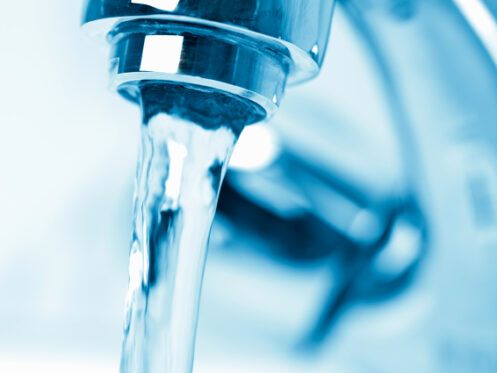Having low water pressure can be annoying as it becomes difficult to wash dishes, shower, or even fully clean your clothes. Low water pressure can result from either a problem with your plumbing system or with the municipal water supply. If you do ever experience issues with low water pressure, here are some steps you can take to determine what is causing the problem and how it can be fixed.
Talk to Your Neighbors
If you suddenly have low water pressure in all your faucets, showers, and other plumbing fixtures, it’s always a good idea to talk to your neighbors to see if they’re also experiencing the same issues with low water pressure. Doing so can help you to determine whether the pressure drop is due to an issue with your plumbing system. If your neighbors also have low water pressure, you can be certain that the issue lies with the municipal water supply and not your home.
It is common for the pressure in the municipal water system to drop whenever work is being done on the system. The pressure can also drop due to a leak in one of the water lines in your neighborhood or a burst water main. In any of these situations, your water pressure will typically return to normal within a few hours. If you and your neighbors still have issues with low water pressure after a day or two, you should then contact the city department to make sure that they’re aware of the issue.
Make Sure the Main Water Shut-Off Valve Is Fully Open
If you’re the only one in the neighborhood experiencing issues with low water pressure, the problem is related to your home’s water supply or plumbing system. In this case, we would always recommend checking to make sure that your main water shut-off valve is fully open. If you have kids, one of them could have messed with the valve so that it’s partially closed. When the valve isn’t fully open, less water will flow into your home and the pressure will be reduced.
The shut-off valve is typically located in the basement or crawl space next to your water meter. The valve can sometimes be in a box buried slightly underground next to your foundation, but this is rarely seen in New Jersey since it can increase the chances of the water line freezing in winter.
In newer homes, the shut-off is usually a ball valve. This type of valve has a straight handle that’s used to open and close it. When the valve is fully open, the handle should run in a straight line parallel to the pipe. If the handle is at an angle, the valve isn’t fully open.
In older homes that still have the original plumbing, the shut-off is usually a gate valve instead. This type of valve has a round handle that looks like the knob on your outdoor hose spigots. To open the valve, all you need to do is turn the handle counterclockwise until it won’t turn any further.
Look at Your Water Pressure Regulator
Your water meter should be located near the shut-off valve, and you should also see a pressure gauge next to the meter. This gauge is the water pressure regulator or pressure-reducing valve. It functions to ensure that your water pressure is never too high since this could seriously damage your plumbing and potentially cause pipes to burst. The pressure in the water line that feeds your home is typically much higher than what your pipes can handle, and the regulator works to reduce the pressure of the water as it enters your home.
The pressure on the gauge should be somewhere between 40 and 60 psi. If the gauge reads anything below 40 psi, you will want to have a plumber inspect the reducing valve. This valve can sometimes fail and result in the pressure suddenly being too low or possibly even much higher than normal. The valve can be adjusted to increase or decrease the pressure, and this is the first thing plumbers will do. If adjusting the valve doesn’t fix the issue, they may then need to replace it. You really don’t ever want to try to adjust the valve yourself as you could easily set the pressure too high and damage your plumbing.
Check for Plumbing Leaks Using Your Water Meter
After checking the pressure gauge, it’s also a good idea to check for plumbing leaks using your water meter. The meter won’t tell you if there is a leak in the main water line leading to your home. But it can help you to know if there is a major leak somewhere in your home that is causing your water pressure to be lower. Before checking the meter reading, you first need to make sure no water is running inside or outside your house. You should then make note of the numbers on the meter. You will then wait to leave your water off and then check the numbers on the meter again after 30 minutes to an hour to see if they’ve gone up. If the meter reading has increased, it indicates that there is a plumbing leak, so you’ll then need to have a plumber find and repair it.
Get Your Plumbing Professionally Inspected
If you still can’t determine why your water pressure is low, you’ll need to have plumbers inspect your home to determine the reason. They can use specialized equipment to check for leaks in the main water line out in your yard and under your foundation. If there are no leaks, it could be that your water line has lots of limescale built up inside it. In areas with hard water, limescale will always build up inside the pipe, slowly reducing the inside diameter of the pipe so that less water flows through it and the pressure decreases. Unfortunately, the only way to fix this issue is to have the water line and any other affected pipes replaced.
Contact the City Water Department
If the plumber can’t determine why your water pressure is low, you will then need to contact the city water department. When any work is being done on the water system in your neighborhood, it is sometimes necessary for the city to shut off the water to your home by closing the shut-off valve near the street or at the edge of your yard. We’ve encountered numerous situations where a home has low water pressure because the city didn’t fully open this shut-off valve once they finished their work. The city water department is the only one that has access to this valve, so it’s a good idea to have them send someone out just to make sure the valve is fully open.
Have a Water Pressure Booster Pump Installed
There are also situations when a home has low water pressure simply because the pressure of the water coming into the building is too low. In this case, the only option for increasing your water pressure is to have a pressure booster pump installed. This pump will be installed where the main water line enters your home and will work to increase your water pressure up to around 50-60 psi so that your plumbing now works properly.
If you’re experiencing issues with low water pressure or any other plumbing problems, you can count on Laury Heating Cooling & Plumbing for help. We specialize in all types of plumbing services including repairs as well as installations and maintenance services for customers in Pennsville, Vineland, and the surrounding areas. Give us a call today for all your plumbing needs.



